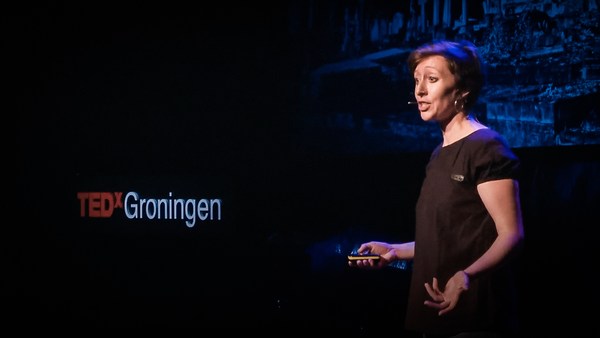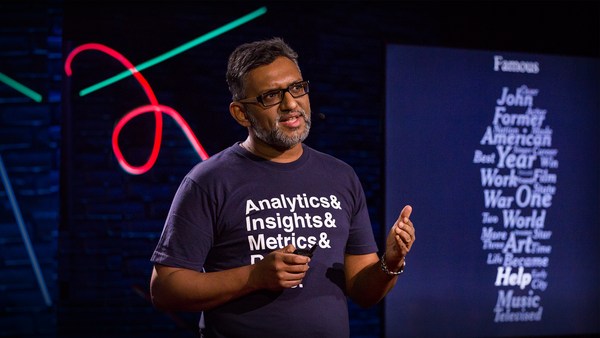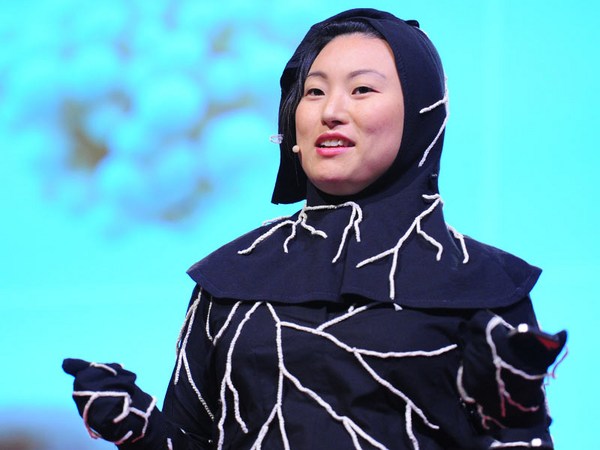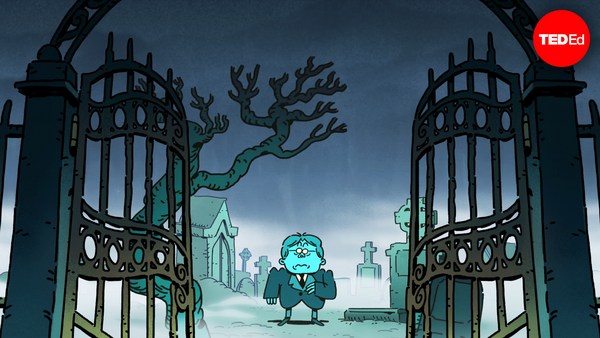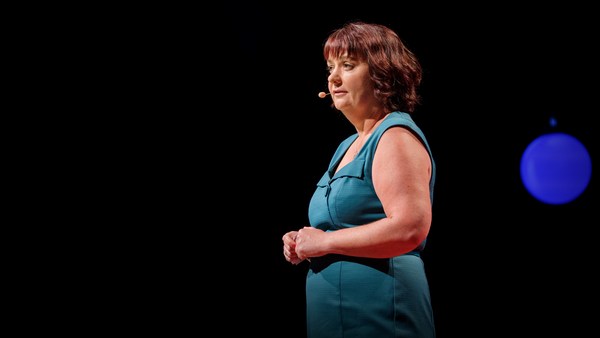When I die, I would like for my body to be laid out to be eaten by animals. Having your body laid out to be eaten by animals is not for everyone.
(Laughter)
Maybe you have already had the end-of-life talk with your family and decided on, I don't know, cremation. And in the interest of full disclosure, what I am proposing for my dead body is not strictly legal at the moment, but it's not without precedent.
We've been laying out our dead for all of human history; it's call exposure burial. In fact, it's likely happening right now as we speak. In the mountainous regions of Tibet, they practice "sky burial," a ritual where the body is left to be consumed by vultures. In Mumbai, in India, those who follow the Parsi religion put their dead in structures called "Towers of Silence." These are interesting cultural tidbits, but they just haven't really been that popular in the Western world -- they're not what you'd expect.
In America, our death traditions have come to be chemical embalming, followed by burial at your local cemetery, or, more recently, cremation. I myself, am a recent vegetarian, which means I spent the first 30 years or so of my life frantically inhaling animals -- as many as I could get my hands on. Why, when I die, should they not have their turn with me?
(Laughter)
Am I not an animal? Biologically speaking, are we not all, in this room, animals? Accepting the fact that we are animals has some potentially terrifying consequences. It means accepting that we are doomed to decay and die, just like any other creature on earth.
For the last nine years, I've worked in the funeral industry, first as a crematory operator, then as a mortician and most recently, as the owner of my own funeral home. And I have some good news: if you're looking to avoid the whole "doomed to decay and die" thing: you will have all the help in the world in that avoidance from the funeral industry.
It's a multi-billion-dollar industry, and its economic model is based on the principle of protection, sanitation and beautification of the corpse. Whether they mean to or not, the funeral industry promotes this idea of human exceptionalism. It doesn't matter what it takes, how much it costs, how bad it is for the environment, we're going to do it because humans are worth it! It ignores the fact that death can be an emotionally messy and complex affair, and that there is beauty in decay -- beauty in the natural return to the earth from whence we came. Now, I don't want you to get me wrong -- I absolutely understand the importance of ritual, especially when it comes to the people that we love. But we have to be able to create and practice this ritual without harming the environment, which is why we need new options.
So let's return to the idea of protection, sanitation and beautification. We'll start with a dead body. The funeral industry will protect your dead body by offering to sell your family a casket made of hardwood or metal with a rubber sealant. At the cemetery, on the day of burial, that casket will be lowered into a large concrete or metal vault. We're wasting all of these resources -- concretes, metal, hardwoods -- hiding them in vast underground fortresses. When you choose burial at the cemetery, your dead body is not coming anywhere near the dirt that surrounds it. Food for worms you are not.
Next, the industry will sanitize your body through embalming: the chemical preservation of the dead. This procedure drains your blood and replaces it with a toxic, cancer-causing formaldehyde. They say they do this for the public health because the dead body can be dangerous, but the doctors in this room will tell you that that claim would only apply if the person had died of some wildly infectious disease, like Ebola. Even human decomposition, which, let's be honest, is a little stinky and unpleasant, is perfectly safe. The bacteria that causes disease is not the same bacteria that causes decomposition.
Finally, the industry will beautify the corpse. They'll tell you that the natural dead body of your mother or father is not good enough as it is. They'll put it in makeup. They'll put it in a suit. They'll inject dyes so the person looks a little more alive -- just resting. Embalming is a cheat code, providing the illusion that death and then decay are not the natural end for all organic life on this planet.
Now, if this system of beautification, sanitation, protection doesn't appeal to you, you are not alone. There is a whole wave of people -- funeral directors, designers, environmentalists -- trying to come up with a more eco-friendly way of death. For these people, death is not necessarily a pristine, makeup, powder-blue tuxedo kind of affair. There's no question that our current methods of death are not particularly sustainable, what with the waste of resources and our reliance on chemicals. Even cremation, which is usually considered the environmentally friendly option, uses, per cremation, the natural gas equivalent of a 500-mile car trip.
So where do we go from here? Last summer, I was in the mountains of North Carolina, hauling buckets of wood chips in the summer sun. I was at Western Carolina University at their "Body Farm," more accurately called a "human decomposition facility." Bodies donated to science are brought here, and their decay is studied to benefit the future of forensics. On this particular day, there were 12 bodies laid out in various stages of decomposition. Some were skeletonized, one was wearing purple pajamas, one still had blonde facial hair visible. The forensic aspect is really fascinating, but not actually why I was there. I was there because a colleague of mine named Katrina Spade is attempting to create a system, not of cremating the dead, but composting the dead.
She calls the system "Recomposition," and we've been doing it with cattle and other livestock for years. She imagines a facility where the family could come and lay their dead loved one in a nutrient-rich mixture that would, in four-to-six weeks, reduce the body -- bones and all -- to soil. In those four-to-six weeks, your molecules become other molecules; you literally transform.
How would this fit in with the very recent desire a lot of people seem to have to be buried under a tree, or to become a tree when they die? In a traditional cremation, the ashes that are left over -- inorganic bone fragments -- form a thick, chalky layer that, unless distributed in the soil just right, can actually hurt or kill the tree. But if you're recomposed, if you actually become the soil, you can nourish the tree, and become the post-mortem contributor you've always wanted to be -- that you deserve to be.
So that's one option for the future of cremation. But what about the future of cemeteries? There are a lot of people who think we shouldn't even have cemeteries anymore because we're running out of land. But what if we reframed it, and the corpse wasn't the land's enemy, but its potential savior? I'm talking about conservation burial, where large swaths of land are purchased by a land trust. The beauty of this is that once you plant a few dead bodies in that land, it can't be touched, it can't be developed on -- hence the term, "conservation burial." It's the equivalent of chaining yourself to a tree post-mortem -- "Hell no, I won't go! No, really -- I can't. I'm decomposing under here."
(Laughter)
Any money that the family gives to the cemetery would go back into protecting and managing the land. There are no headstones and no graves in the typical sense. The graves are scattered about the property under elegant mounds, marked only by a rock or a small metal disk, or sometimes only locatable by GPS. There's no embalming, no heavy, metal caskets. My funeral home sells a few caskets made out of things like woven willow and bamboo, but honestly, most of our families just choose a simple shroud. There are none of the big vaults that most cemeteries require just because it makes it easier for them to landscape. Families can come here; they can luxuriate in nature; they can even plant a tree or a shrub, though only native plants to the area are allowed. The dead then blend seamlessly in with the landscape.
There's hope in conservation cemeteries. They offer dedicated green space in both urban and rural areas. They offer a chance to reintroduce native plants and animals to a region. They offer public trails, places for spiritual practice, places for classes and events -- places where nature and mourning meet. Most importantly, they offer us, once again, a chance to just decompose in a hole in the ground. The soil, let me tell you, has missed us.
I think for a lot of people, they're starting to get the sense that our current funeral industry isn't really working for them. For many of us, being sanitized and beautified just doesn't reflect us. It doesn't reflect what we stood for during our lives. Will changing the way we bury our dead solve climate change? No. But it will make bold moves in how we see ourselves as citizens of this planet. If we can die in a way that is more humble and self-aware, I believe that we stand a chance.
Thank you.
(Applause)
